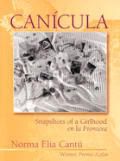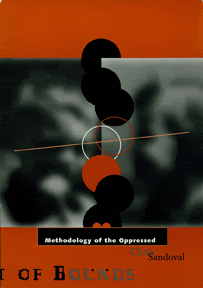Differential Movement at Work
Chela Sandoval utilizes Barthes concept of mythology (“both the objects to be decoded and successful examples of his decoding method at work” (Sandoval 89)) as an origination point for her own concept of the methodology of the oppressed. While there are several “technologies” inherent to Sandoval’s theoretical construct, one key element is that of differential movement. Sandoval states that differential movement enables “meta-ideologizing as political intervention” (111), in that “meta-ideologizing depends on…‘flexibility’—of perception, consciousness, identity, and tactics in relation to power…[It] moves in, through, then outside of dominant ideology’ (111); or, in Barthes terms, meta-ideologizing is the “ideologization of ideology” (qtd in Sandoval 109). Differential movement, then, is this passage in, through, and out of ideologies for explicitly political ends.
 To better understand how such a concept functions practically, one can examine Norma Elia Cantu’s Canicula: Snapshots of a Girlhood en la Frontera and the manner in which the narrator addresses hair and hairstyling. Toward the end of the ethnography, we find that the narrator learns “all about being a beautician” when visiting her Mamagrande in Monterrey. Her cosmetology classes entail studying “theory, memorizing scientific names, theories of chemical reactions for permanents and dyes, or…lectures on the history of beauty treatments, of beauty care” (Cantu 127-8). Once she returns home, the narrator becomes the “unofficial…hairdresser for friends and family” (128-9) for the next seventeen years. The beehives, bouffants, and pages boys (128-9) were no doubt inspired by the hairstyles of the actresses they watched on television, as the narrator and her friends sometimes watched programs from “around four o’clock [in the afternoon]…until ten or eleven” (120) at night. At this juncture in her life, she is no longer the “awkward teen” who does not shave her legs, pluck her eyebrows, or wear makeup (60-1); instead, Cantu’s narrator operates within the dominant ideology and its standards for female beauty. She creates hegemonic images through the aesthetics of hairstyle.
To better understand how such a concept functions practically, one can examine Norma Elia Cantu’s Canicula: Snapshots of a Girlhood en la Frontera and the manner in which the narrator addresses hair and hairstyling. Toward the end of the ethnography, we find that the narrator learns “all about being a beautician” when visiting her Mamagrande in Monterrey. Her cosmetology classes entail studying “theory, memorizing scientific names, theories of chemical reactions for permanents and dyes, or…lectures on the history of beauty treatments, of beauty care” (Cantu 127-8). Once she returns home, the narrator becomes the “unofficial…hairdresser for friends and family” (128-9) for the next seventeen years. The beehives, bouffants, and pages boys (128-9) were no doubt inspired by the hairstyles of the actresses they watched on television, as the narrator and her friends sometimes watched programs from “around four o’clock [in the afternoon]…until ten or eleven” (120) at night. At this juncture in her life, she is no longer the “awkward teen” who does not shave her legs, pluck her eyebrows, or wear makeup (60-1); instead, Cantu’s narrator operates within the dominant ideology and its standards for female beauty. She creates hegemonic images through the aesthetics of hairstyle.According to Sandoval though, for differential movement to function properly, marginalized people must not simply co-opt a dominant ideology and accept it as their own, but be able to move outside of (as well as inside of) that ideology. As readers, we witness the narrator’s subversion of mainstream white culture when she writes:
Every morning when I’d wash the coffee pot, I’d collect the grounds in an old can. When I’d saved enough, I’d conduct the experiments—I’d dyed my doll’s blonde hair with the liquid made with distilled syrup from the grounds and the gummy resin from the mesquite tree. (97)
The blonde hair of her doll, similar to the “missal with the picture of a blonde child receiving communion” (56), reinforces a superficial form of beauty the Cantu’s narrator does not embody. Instead of dying her own hair blonde, she contradicts (moves outside) dominant ideology and physically alters the appearance of her doll with grinds, syrup, and resin. Additionally, we see that her initial reaction to the jeers of the “pendejas” to pluck her eyebrows and shave her legs during her teenage years results in the narrator and her friend (Rosario) fighting with these girls after school.
Through a fluid, combinatory ideology, Cantu’s narrator can both actively engage with, and work in contradistinction to, the dominant modes of thought and perception with regards to feminine beauty; it is this fluidity that demonstrates differential movement and the concept of meta-ideologizing. Differential movement, similar to a mestiza consciousness, undermines static binaries in an effort to create a third space, a de-colonial imaginary.


1 comment:
I have to wonder, though, if the championing of (often private) symbolic gestures (dying the doll's hair) only further marginalizes the narrator's ethnic culture as an archaic ritual (ineffectual in the public sphere) in the face of the practical reality of her job.
Post a Comment